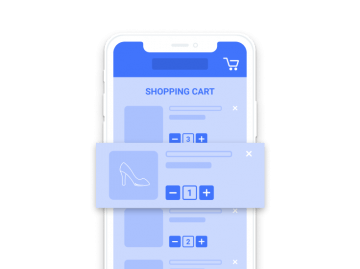ASO, or App Store Optimization (application optimization for app stores) is the process of maximizing the visibility of applications in the store search engine and increasing the number conversions in the area of application installations. Creating a well-designed application that responds to the needs of users is the basic factor influencing its market success. However, an equally important element is to ensure that users can find it.
Why is it worth to work on ASO?
A conscious approach to the promotion of applications – including in regard to the App Store Optimization is important due to the high competition on the mobile applications market. Current data (for 2018) shows that there are nearly 4,000,000 (four million) applications available for Android devices and over 2,000,000 (two million) for iOS devices. Furthermore, these numbers are growing geometrically.
According to TechCrunch, over 80% of iOS applications are so-called “zombie apps”. Zombie apps are not popular enough to be in the top 300 in their category, and finding them is possible only by entering the appropriate phrase, e.g. its name, in the internal app store search engine.
Owners of Android applications do not have to be afraid of this problem – Google Play works in this respect slightly different than the App Store – but much greater competition (twice as many applications available) significantly hinders reaching the user.
The 8 most important rules for App Store Optimization


1. Choosing the right name
The name is one of the most important factors affecting the visibility of your application in the app store.
When creating a name, first of all remember about the guidelines and limitations of Google Play and the App Store – e.g. the character limit (50 for Android applications, 30 for iOS applications). You should also ensure its coherence: if you intend to distribute your application using various platforms, it is better to use uniform names for each of them. For this reason, you should always apply the most stringent determinants: for example, create names shorter than 30 characters – even if the Google Play limit is 50.
Remember what the user viewing the app store will see: the icon and name, fragment of the description and two graphics presenting the two selected application screens. These elements should be selected in such a way that they immediately inform about the application’s use. The name should be simple, easy to remember and pronounce, unique and without any special characters (!@#$%^&*, etc.).
2. Selection of relevant keywords
Adequate selection of keywords and their placement in the application description in the app store can determine its popularity. In the case of the App Store, you get the opportunity to manually enter the most important keywords that define the application and allow the user to find it.
In the case of Google Play, the issue is a bit more complicated: the store automatically “pulls” the most important keywords from the description of the application. This does not mean, however, that we should overuse them – Google easily recognizes synonyms, and excessive keyword saturation (so-called keyword stuffing) most often works to the disadvantage of the description, making it less accessible to users. Therefore, it is best to write a reliable, substantive text about the most important features and benefits of your application.
Choosing the right keywords is worth supporting with tools designed for SEO and keyword research. The most popular ones include tools offered by Moz (Moz Keyword Explorer) and Ahrefs (Ahrefs Keywords Explorer) or Uber Suggest neilpatel.com/ubersuggest/.
3. Preparation of the application description in the app store
When writing a description, there are some very important points to keep in mind:
Present the benefits of the application already in the first sentences of the description
People browsing the app store will first see only the opening part of the text. It is best to inform them at this stage that they have found what they were looking for.
Focus on content, not on promotion
Users browsing the app store are looking for reliable information about the functioning of the application, so the description of the function will be much better than marketing promises.
Ensure the clarity of the text
It is best to use short, compact paragraphs, break up the text by itemizing it and communicate the value in an unambiguous, unmistakable way.
4. Preparation of an attractive icon that stands out from the competition
The choice of an icon is the same as choosing the name. However, app branding is a broader concept and may also include work on the entirety of the visual identification of your product.
A common solution is to use the company logo (or its part – e.g. a signet – or its variant) as the application icon. This solution will work well for recognizable brands; for online stores it is almost obligatory, and x-kom can be a good example of it.

In the case of press applications, icons loosely referring to the logo are very popular. WIRED, The New York Times and the Wall Street Journal provide a good example. These are very stylish icons that explicitly suggest the topic and, at the same time, remain in direct relation to the original logo.

5. Supplement the description with graphics
Pictures and screenshots are a perfect addition to the description of the application’s functionality. The most important rules for their selection are as follows:
Make sure they are up to date
This is especially important for frequently updated applications. Graphic materials placed in the app store should present its latest version.
Communicate the benefits using the client’s language
It is also worth remembering the benefits not directly related to the main function of the application: e.g. the ability to observe price changes. Such things can be communicated with a screenshot.
Make sure photos are displayed in the right order in the app store
You can include more images in both Google Play and the App Store than you see when you visit the offer page. When entering the application page, the user initially only sees the first 2 or 3 images. So you should choose them in such a way that they encourage him to look at the others.
Keep graphical consistency, but create a diverse presentation
The images should present the full spectrum of application’s abilities; however, remember about compositional consistency. Although individual images are independent of each other, in the app store, they are necessarily displayed side by side. For this reason, users perceive them as a whole. It is necessary to ensure coherence throughout the whole presentation – if not in terms of the composition, at least conceptually.
An alternative to static graphics are videos with the presentation of the most important functions. You should not go overboard with their length and quantity. Entertainment applications are an exception – in this case: the more, the better. Game trailers, including for mobile games, enjoy huge popularity.
6. Make regular updates
Responding to user comments and informing them about corrected bugs in the latest update has a positive impact on their rating and, ultimately, on the position of the application in the stores.
7. Ask users for a rating
Many applications send users a request to rate them in the app store. Not without a reason: user ratings have a direct impact on the visibility of the app in the search results and app store rankings. Unfortunately, many application owners make the mistake of attacking users with intrusive requests for rating in the form of annoying pop-ups. Meanwhile, these requests should be subtle and not interfere with the use of the application. It is best to ask for a rating “casually” – e.g. immediately after the user purchases a product or comments a transaction in the m-store.
What matters here – naturally – is the rating itself. In particular, the latest rating are very important; surveys conducted by the Incipia agency in 2017 showed that they have up to 7x more impact on the decision to download than the overall average rating since the launch of the application. So if the latest user ratings do not meet your expectations, then you should identify the problem and try to fix it.
User comments and ratings are also a very important source of knowledge about the further direction of your product development. Remember that the app store is only one of the places where internet users can comment on your application. It is worth to look into internet monitoring and the most important social media from the point of view of your target group; do not forget about reviews and websites collecting them.
8. Location of the offer page
A good practice in the case of applications intended for the international market is also the location of the offer page, i.e. creation of separate language versions for users from different countries. Translation into Spanish and Chinese – as well as the most popular European languages: French, German and Russian – can significantly increase the number of downloads among non-English speakers.
When preparing the translation, follow the principles promoted by Google: i.e. do not use one-to-one translation, but focus on localization, i.e. contextual translation. This is important because users who use other languages can search for your application in a completely different way, using completely different phrases.
Summary
The mobile application market is developing very dynamically. Also the appearance and possibilities of stores are changing: Apple streamlines its App Store on average once or twice a year; the latest announcement of its reconstruction took place at this year’s WWDC conference. And changes in Google Play, although more subtle, are not rarer (relating to, for example, algorithms).
As a consequence, activities falling under App Store Optimization are also changing. Therefore, the most important principle of correct ASO is to stay up to date with changes and react with the help of thoughtful updates of the offer page… and the application itself. Ultimately, it is the most important element of the puzzle.
You might also like

Increasing mobile app retention focuses on the users returning…

Most marketing and e-commerce experts agree that m-commerce applications…

The number of people shopping through mobile devices is…

There has been much talk of e-commerce in recent…

App Store Optimization, or ASO, entails the process of…




